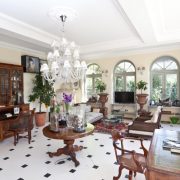Why we have a very happy client in Dorset
Extending any period property requires consideration of several significant factors including aesthetics, scale and proportion as well as functionality and efficiency.
And this was certainly true for a recent project undertaken in Dorset for a private client.
The brief
Nicholas Jacobs Architects was asked to provide an ancillary space for the client’s private collection of natural history.
Our solution was to provide an orangery type space to the east of the existing house, which was once the vicarage for the 500-year-old church, adjacent to the site.
Originally built in the 19th Century, the main range has attractive stucco and ashlar detailing along with coursed stone to the north under a slate roof.
A Victorian wing was added in 1862 and the house is Grade II Listed as being of Architectural or Historical Importance.
Because of the historic significance of the building and the fact that the church was adjacent, it was important to provide a new building that recognised these factors.
Any alteration or extension required the support of the conservation officer and would also require archaeological recording.
NJA therefore proposed early engagement with the local authority and also sought advice from a local archaeologist.
The scheme developed into the orangery form with stucco walls and ashlar detailing in a similar vein to the main building.
This respect of the building and setting provide a coherent development that will stand the test of time.
Bring the outside in
Orangeries provide a glorious middle ground between indoors and out.
They provide a beautifully bright area, where different aspects of the home can converge, either working as a standalone snug, or maybe combining kitchen, dining-room and sitting-room in one.
Of course orangeries can work in almost any situation: old houses, new builds, small gardens and vast estates.
The important consideration is always scale and massing set against the existing building.
With this project, the new building remains subservient to the main building, but because of the clear separation, it allows a development in scale of the architectural features, providing double height ceilings and large French windows to the southern aspect.
This provided the interior space the client’s property lacked, good natural light into the heart of the room and light reflective surfaces which helped enhance the interior’s natural ambiance.
The orangery features
The orangery comprises of eight large curved head windows and two square head windows to maximise the daylight into the room.
Slim glazing was used to match the look of the existing property while meeting current building regulations.
The render colour was bespoke and manufactured in Scotland to match the colour of the existing stonework.
Stone effect quoins were formed in render to complement the existing property that had been partly rendered.
In order to complete the blend between the extension and the house we used second hand, pre-weathered welsh slate which matched the existing house roof lead. This was also used for the parapet gutters and the hips of the roof.
Local lime stone with slate inset was used internally, to provide a practical floor, which incorporates hidden sockets as well as underfloor heating.
Cornicing was a traditional fruit embossed fibrous plaster, reminiscent of the 19th century.
The process
Because of the unique nature of the building, it was important to choose the right building contractor to deliver the project.
Nicholas Jacob Architects proposed a two stage tender approach which allowed the client to choose a contractor who had the expertise but with whom they could keep an eye on cost and cost control.
Our quantity surveyor oversaw this process and continually tracked the cost as the project developed.
Greendale Construction was chosen because they not only had the appropriate experience, but also because they demonstrated a good partnering approach and fully engaged with the design team.
The project remained design-lead and was delivered on time and within budget because of this collaborative approach to design and construction.
The conclusion
The project lead, Shaun Soanes, explained that “the client brief was fully delivered and the quality of light within the building is exactly what the owners were expecting”. He added: “They could not wait to move in and their furniture arrived as the contractor was clearing out.
“We know we have a very happy client!”






Leave a Reply
Want to join the discussion?Feel free to contribute!